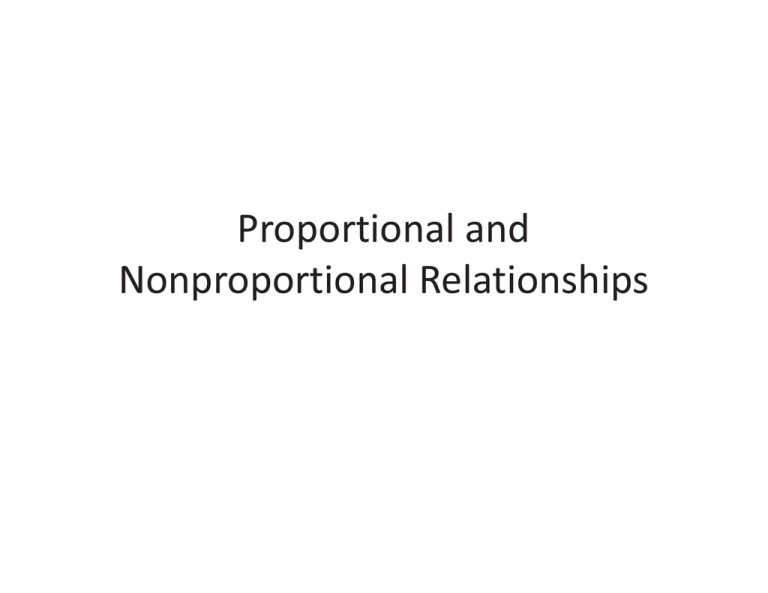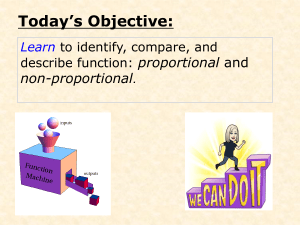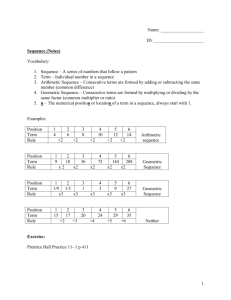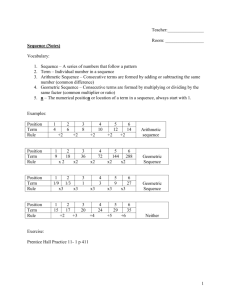Proportional and Nonproportional Relationships
advertisement

Proportional and Nonproportional Relationships Proportional Relationships If a linear equation can be written in the form of ࢟ ൌ ࢞ Then the relationship is PROPORTIONAL. Based on the form described above, PROPORTIONAL RELATIONSHIPS vary directly. Example 1 – Proportional Relationships Marcos is a personal trainer at a gym. In addition to his salary, he receives a bonus for each client he sees. Number of 1 2 3 4 5 ࢞ Clients Bonus Pay 45 90 135 180 225 ࢟ ($) First, graph this relation and describe any pattern between the number of clients and the amount of bonus pay. Then, write an equation to describe this relationship: So we have… The graph demonstrates a linear relationship and it also passes through the point ሺǡ ሻ because when Marcos sees 0 clients, he receives 0 pay. Example 1 - Continued Now that we have seen that the graph of the Proportional Relationship is linear, we need to calculate the slope – the rate of change – so we have… ࢈࢛࢙ࢇ࢟ ࢘ࢇ࢚ࢋࢌࢉࢎࢇࢍࢋ ൌ ͓ࢌࢉࢋ࢚࢙ Remember, you can use any two of the given points… ૢ െ ࢘ࢇ࢚ࢋࢌࢉࢎࢇࢍࢋ ൌ ൌ െ So for each client that Marcos sees, he earns $45 in bonus pay. Example 1 - Continued Since we know that PROPORTIONAL RELATIONSHIPS vary directly, we know that… ࢟ ൌ ࢞ Where, for this problem ൌ ൌ … so we have… ࢟ ൌ ࢞ We can use this equation to find the amount of bonus pay, ࢟, that Marcos will receive for seeing ANY number of clients, ࢞. You Try 1 A professional soccer team is donating money to a local charity for each goal they score. Write an equation to describe this relationship. Then use this equation to predict how much money will be donated for 12 goals. Number of Goals Donations ($) ࢞ ࢟ 1 2 3 4 5 75 150 225 300 375 If you were correct, you should have found the equation to be… ࢟ ൌ ૠ࢞ And that if the soccer team scores 12 goals, then they will have donated $900. Proportional vs. Non-Proportional Relationships As we should have noticed that PROPORTIONAL RELATIONSHIPS vary directly… This simply means that for PROPORTIONAL RELATIONSHIPS, the graph will ALWAYS go through the origin, ሺǡ ሻ. On the other hand, NON-PROPORTIONAL RELATIONSHIPS, do NOT vary directly… This means that for NON-PROPORTIONAL RELATIONSHIPS, the graph will NOT go through the origin, ሺǡ ሻ. Example 2 – Non-proportional Relationships Write an equation in function notation for the given graph: First, we should probably construct a table for a few of the points on the graph… ࢞ ࢟ 1 2 3 4 9 12 15 18 Now we can use the table to find the RATE OF CHANGE… Example 2 - Continued We should have that the rate of change is… ࢟ െ ࢟ ൌ ࢞ െ ࢞ Remember, we can use any two of the given points… െ ૢ ൌ ൌ ൌ െ So the rate of change (or the slope) of the line is 3. Now, since we know that NON-PROPORTIONAL RELATIONSHIPS do NOT vary directly, we CANNOT use… ࢟ ൌ ࢞ Example 2 - Continued Moreover, we know that NON-PROPORTIONAL RELATIONSHIPS do NOT pass through – their Y-Intercepts are not – the origin, ሺǡ ሻ. Instead, we know that the graph passes through – has a Y-Intercept of – ሺǡ ሻ. So our equation is… ࢟ ൌ ࢞ So In FUNCTION NOTATION, our equation is… ࢌ ࢞ ൌ ࢞ We can verify this by using the table to check points… ࢞ ࢞ ࢟ 1 2 3 4 9 12 15 18 You Try 2 Write an equation in function notation for the graph: If you were correct, you should have found that… ࢟ ൌ ࢞ െ





